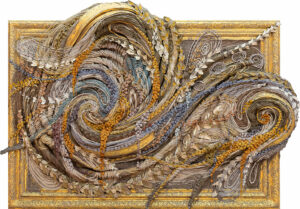“I know now, Lord, why you utter no answer. You are yourself the answer. Before your face questions die away. What other answer would suffice?” — C.S. Lewis, Till We Have Faces
ONLY A FEW know his face — one of these few perhaps God himself, to whom artist Arce prays to while he paints.
The publicity-shy artist opened his sixth exhibition with Art Underground, Voltaje, with a rather strange press conference in the San Juan gallery on Jan. 14. One of his works, the triptych Conduit of Divine Energy – Powered, loomed over a laptop, from which he spoke. The picture on display is of him, but with his back turned while looking at one of his works.
From this call, Arce discussed his work: layers of oil paint over draped canvas spills over the golden frames, forming abstract figures in dusty pastels, some outlined in gold. An initial viewing might lead one to mistake them for collages of dried flowers or some such, but each one of these swirls and stalks are made of oil paint. The space in which these works (10 of them) reside was designed by him, as well. Light strips hang from a frame above, snaking their way through the painting: these, according to the artist, symbolize a portal from the spiritual and physical worlds.
Spirituality is at the heart of Arce’s work: he told us in a group interview that he starts the day at 4 a.m. with the rosary. “Kahit isang decade lang (even if it’s just one decade,” he said. In his studio, he plays either classical or religious music. “Pag pasok sa studio, iyong buong process, para siyang isang buong dasal (when I enter the studio, the whole process is like a whole prayer).”
The title of the exhibit,Voltaje, comes from the power blackouts caused by the typhoon season of 2024. One such typhoon killed the power at his Tagaytay studio for four days, interrupting his work. “Pumasok iyong Voltaje. Kailangan ng energy pala. Kailangan ma-electrify iyong area pati ’iyung thought process ko, para mas mapabilis iyong gawa ko, mag move lahat iyong mga nasa utak ko (Voltaje came into my mind. Turns out that energy is needed. The entire area needed to be electrified, including my thought process, so that my work would be speeded up, so what was in my brain could start moving).
“Nag-start siya with mga bulong-bulong, or something doon sa utak ko. Sinisimulan ko siya, nagcocontemplate ako sa studio. Nasa gitna ako (It started with whispers in my mind. I start, while I’m contemplating in the studio. I’m in the center),” he said.
“Effect of rosary prayer and yoga mantras on autonomic cardiovascular rhythms,” a comparative study by Luciano Bernardi et al. in 2001 published in The BMJ said, “Both prayer and mantra caused striking, powerful, and synchronous increases in existing cardiovascular rhythms when recited six times a minute.” It concludes that “Rhythm formulas that involve breathing at six breaths per minute induce favorable psychological and possibly physiological effects,” particularly with anxiety. This means that repetitive prayers — whether chants or Catholic prayers, so long as they’re said in a certain rhythm — have a physical, tangible effect on well-being, if only in the moment.
“Iyong dating magulo na mga bulong doon sa mind ko, through prayers, pinapakalma niya (The noisy whispers in my mind, through prayers, are calmed),” he said, relating his process. “Minsan, sobra pa doon sa pagpapakalma. From bulong, naging prayers. Iyong resulta, parang answered prayer siya (Sometimes, it’s more than just calming. From whispers it becomes prayers. The result looks like an answered prayer),” he said.
“Wala iyang reference. Kung ano lang nararamdaman ko that time (These don’t have a reference. It’s just what I feel in the moment),” he said about his works. “Iyong overflowing ng emotions ko, based on prayer during that moment. Iyon yung lumalabas lahat doon sa artworks ko (That all comes out in my artworks).”
Well, save one: asked why they’re mostly in patterns of swirls, he said, “You can imagine na kapag may prayer ka (when you have a prayer), or you’re manifesting something… parang umiikot sa wind iyon (it is like it swirls in the wind). Paulit-ulit mong sinasabi, paulit-ulit mong dinadasal… nangyayari na siya. Nagkakatotoo na siya (You say it over and over; you pray for it over and over… it starts happening. It starts coming true).
“Ibulong mo sa hangin (whisper it to the wind),” he said.
As for his secrecy, he said, “mas importante sa akin, or mas madaldal, iyong kung ano ang nasa utak ko. Iyong physical presence ko… introvert lang ako. Ayoko makipag-socialize (What’s more important to me, or more expressive, is what’s in my mind. My physical presence… I am an introvert. I don’t like socializing),” he said, and a part of it, he says, is because he can’t explain his work — although he did a good job doing so during the press conference, perhaps because he was hidden by, and through, a screen.
“Being invisible is also a power,” he says, and he says he enjoys attending his exhibits incognito and hearing the praise and/or criticism of his work. “Very authentic lahat iyong naririnig ko. ‘Wala’ doon iyung artist (Everything I hear is very authentic. The artist is ‘not’ there),” he says, like a wink.
Voltajeby Arce is on view until Jan. 28 at Art Underground, 2/F Mabini180, 180 Mabini St., San Juan. — Joseph L. Garcia

